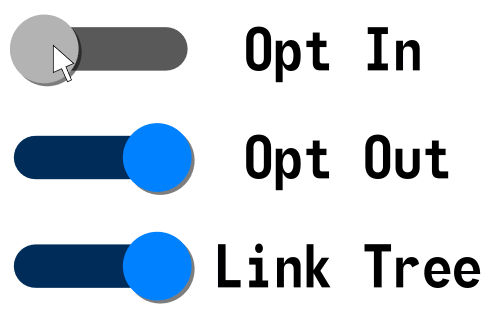Blog

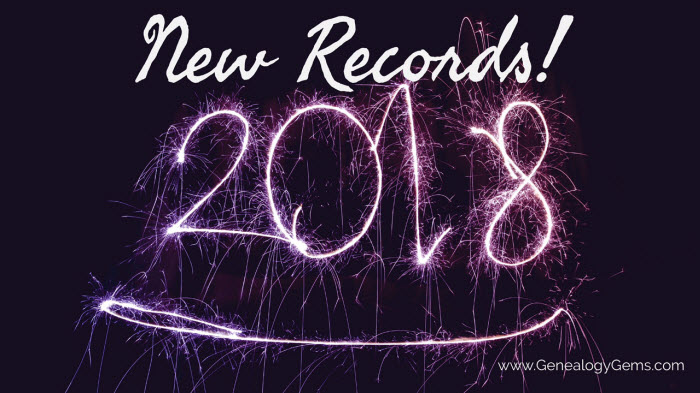
New year, new records for genealogy!
Kick off 2018 with a diverse group of new genealogy records to explore online this week! Included are historical and vital records for British genealogy, Irish newspapers, Scottish records, and Palestine naturalization applications.

British Historical & Vital Records
Lots of new genealogy records are available for England this week at Findmypast! Start with Britain, Histories & Reference Guides, which contains more than 65 volumes about genealogy, heraldry, paleography, geography, and more. These volumes will expand your knowledge about your ancestor’s life and how your ancestors lived through the centuries.
Next, if you’ve got ancestors in Greater Manchester, you’ll want to explore Greater Manchester Burials 1570-1990 and Greater Manchester Marriages 1570-1936. Both collections pertain to the historic county of Lancashire and contain names, dates, and transcripts of the original registers. These collections both come from FamilySearch.
Finally, Northamptonshire Memorial Inscriptions may reveal your ancestor’s death date, burial place, as well as the names of other family members for your family tree. This collection includes 17 cemeteries, churchyards, and other places, and the records span from 1422 to 2015.
Irish Newspapers
The Church of Ireland’s record repository, Representative Church Body Library (RCBL), has announced that all 19th-century editions of the Church of Ireland Gazette have been added to the online archive of the weekly newspaper. The full archive is free to the public and covers years 1856 – 1923.
The British Newspaper Archive has added the Dublin Evening Telegraph to their collection of historic newspapers recently. This paper spanned 1871-1924, and this collection has over 12,000 issues available online.
Scottish Records
Recently added to Ancestry.com are Carnegie Music Institution Registers, 1910-1920 from Dunfermline, Fife. This school was founded through a trust set up by Andrew Carnegie, and school records include names, year and term of attendance, resident, and subject studied.
Additional news for Scottish research comes from the University of Virginia School of Law.
30 years after they acquired a trove of legal documents from Scotland’s Court of Session, the supreme legal court there, the Law School’s Arthur J. Morris Law Library is building a digital archive and reaching out to partners “across the pond” to open these legal history materials to scholars and the public. According to the press release, the library is planning to release the first batch of documents online soon. When completed, users will be able to search through a single document or the entire collection, peruse the rich data provided for each case, and download documents for free.
Palestine Naturalization Applications
A fascinating new collection at MyHeritage is the Mandatory Palestine Naturalization Applications, 1937-1947. From the collection description: “This collection is a unique and rich compilation of records documenting the efforts of individuals, mostly Jews, and sometimes their entire families, to establish citizenship in Mandatory Palestine, which was under British administration at the time. The collection contains photos, histories, passports, and other various forms providing details for each applicant.”
Let 2018 be your year to break down brick walls!
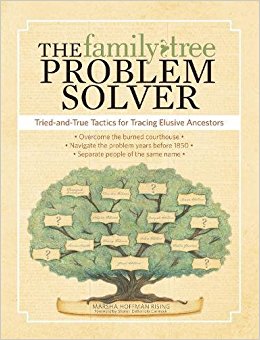 Has your family history research hit a brick wall? Marsha Hoffman Rising’s best-selling and recently updated book The Family Tree Problem Solver has the solutions to help you find the answers you seek. Get tips on finding vital records before civil registration, finding “missing” ancestors on censuses, advanced court records, workarounds for lost or destroyed records, common names, case studies, and more! This revised edition also includes new information about online research techniques and a look at the role of DNA research. Click here to order now!
Has your family history research hit a brick wall? Marsha Hoffman Rising’s best-selling and recently updated book The Family Tree Problem Solver has the solutions to help you find the answers you seek. Get tips on finding vital records before civil registration, finding “missing” ancestors on censuses, advanced court records, workarounds for lost or destroyed records, common names, case studies, and more! This revised edition also includes new information about online research techniques and a look at the role of DNA research. Click here to order now!
Disclosure: This article contains affiliate links and Genealogy Gems will be compensated if you make a purchase after clicking on these links (at no additional cost to you). Thank you for supporting Genealogy Gems!
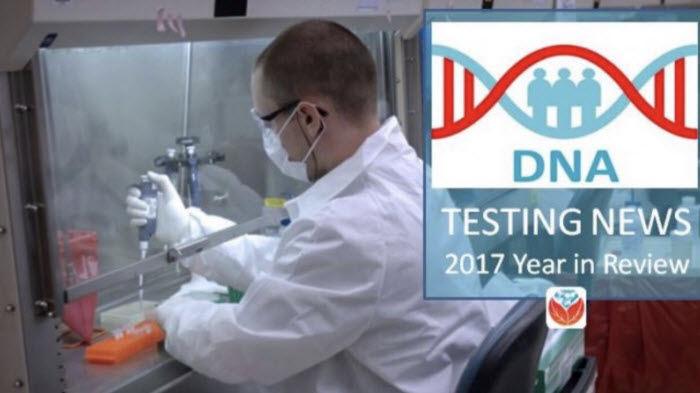
DNA Testing News: 2017 Year in Review
Plenty of DNA testing news crossed our desks in 2017! Advances in genetic genealogy include an AncestryDNA database that doubled in size, new options for participants, more health-related information and a new global genetic tree. Catch up on these developments before 2018 brings us even more DNA news!

DNA Testing News in 2017
The genetic genealogy industry is growing at a break-neck pace. Ancestry.com has amassed the largest DNA database by doubling its testing pool in 2017. Over 6 million people have now tested there. This is great news for those seeking genetic connections. As these databases grow larger, it’s also clear that genetic data–correlated with genealogical data–has tremendous ability to provide us with other answers about ourselves.
In November, MyHeritage announced an effort by their scientific team to “study the relationship between genetics and behavior, personal characteristics, and culture.” These studies are not new, as 23andMe is in open hot pursuit of the connections between genetics and our health, and always has been.
Increased options for your DNA testing experience
All of our genetic genealogy companies are involved in research on one level or another and every person who swabs or spits has the opportunity to participate in other research projects (click here to read up on the consent policies at each company). At the time of testing, you have the option to opt in or out of this research, and the ability to alter that decision at any time after you test, by accessing your settings. According to an article in Fast Company, it seems we as a community are very interested in helping with research: 23andMe reports an over 80% opt-in-to-research rate among their customers. And I’ve got some breaking news for you: Family Tree DNA recently ran a consumer awareness campaign to reinforce the message that they will never sell your genetic data.
Health data and research
All our genetic genealogy companies realize that you might want to do more with your data than just look for your ancestors. This year Family Tree DNA has partnered with Vitagene in an effort to provide insight into your health via your genetic genealogy test results. Of course 23andMe is the leader in health testing when we look at our top genetic genealogy companies. This year 23andMe finally succeeded in passing several of their health tests through the FDA, a huge leap forward in their efforts to provide health testing directly to consumers.
While health testing has certainly seen an explosion of interest this year, it is not the only way that our companies are using the data they have amassed. AncestryDNA took the DNA and pedigree charts of two million customers who consented to research and, using some really fancy science, were able to provide amazing insight into our recent ancestral past with the creation of their genetic communities. These genetic communities enhance our understanding of our heritage by showing us where our ancestors may have been between 1750 and 1850, the genealogical “sweet spot” that most of us are trying to fill in.
A global genetic family tree
Living DNA, a relative newcomer to the genetic genealogy arena, announced in October of 2017 their intention to use their database to help create a One World Family Tree. To do so, they are collecting DNA samples from all over the world, specifically those who four grandparents lived in close proximity to each other. Along with this announcement, Living DNA is allowing individuals who have results from other companies and want to help with this project, to transfer into their database.
So it seems that with growing databases come growing options, whether to opt-in to research, to pursue health information from your DNA test results, or to help build global databases for health or genealogy purposes. Recognizing the growing appeal to non-genealogists as well, AncestryDNA added to their list of options the ability to opt-out of the match page, and there are rumors that Living DNA will soon be adding the option to opt-in to matching (they do not currently have a cousin-matching feature as part of their offering).
Keep up with DNA testing news
It can be tricky to keep up with the seemingly relentless flood of DNA advances, so follow us here at Genealogy Gems, where I report on the most important DNA testing news for your genealogy research. You can stay up-to-date by following us on Facebook, subscribing to our free weekly e-mail newsletter and tuning in to the free Genealogy Gems Podcast.
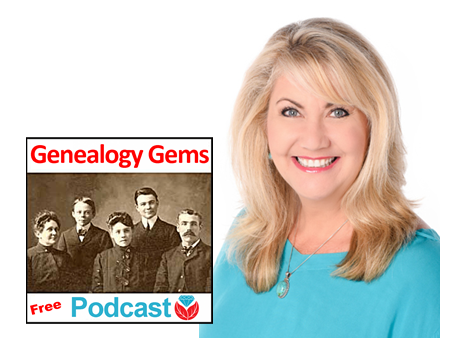
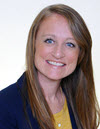
The Author: Diahan Southard
Your DNA Guide
Diahan Southard is Your DNA Guide here at Genealogy Gems! She has worked with the Sorenson Molecular Genealogy Foundation, and has been in the genetic genealogy industry since it has been an industry. She holds a degree in Microbiology and her creative side helps her break the science up into delicious bite-sized pieces for you. She’s the author of our DNA guides Getting Started: Genetics for Genealogists, and Y Chromosome DNA for Genealogists (click STORE in the menu above)
Disclosure: This article contains affiliate links and Genealogy Gems will be compensated if you make a purchase after clicking on these links (at no additional cost to you). Thank you for supporting Genealogy Gems!
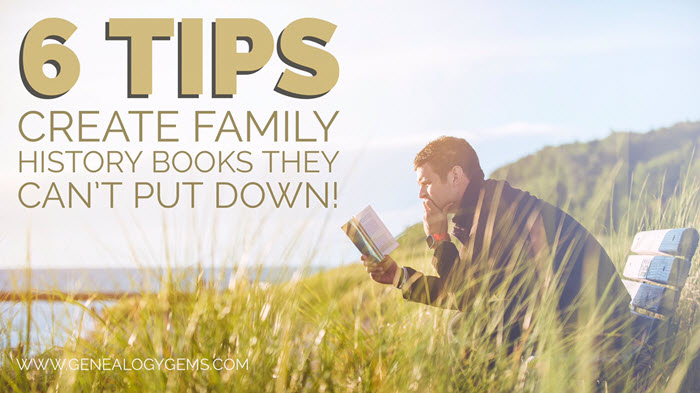
6 Tips to Create Family History Books They Can’t Put Down
I started creating family history books a decade ago. These 6 strategies helped me share my genealogy research findings in books that made fascinating, affordable and easy-to-mail gifts.

My Dilemma: How to Share My Family History
Several years ago, I began sharing my family history research with my relatives. We don’t live close to them, so I had to mail whatever I shared.
Initially, I sent CDs full of digitized photos and documents, but they just didn’t get looked at like I had hoped. Individual items on CDs didn’t easily or smoothly tell a story.
Also, I think some of my relatives found the technology a bit intimidating back then. And many people just don’t care for viewing photos, documents or stories on a computer screen.
The Solution
I found that the solution to sharing with all family members was a good old fashioned book!
Books are still hard to beat for telling a story in words and pictures in an extremely easy to use way. Self-publishing little hardbound family history books helped me break up my research sharing into digestible chunks. And the best part? My family actually opened and read them them cover to cover.

Cover of the family history book I created about my Grandma.
But where to begin the family story, and where to end it? It’s tempting to tell the story of one generation in each book. But even this can become an overwhelming project, with an end product that is not as meaningful for your readers (lots of dates and names, without a lot of room for stories or photos).
I wanted my family to get to know our ancestors intimately. For me, that meant focusing on one person or one event instead of entire generations or families.
Where to Start
I started with my favorite ancestor: my grandmother.
I’ve transcribed many years of her diaries, which are full of her stories about years spent in nurse’s training. Those journal entries taught me so much and led me to some great discoveries about her life. They also dovetail beautifully with my collection of photos from that period.
So I decided that my starting point would be her graduation from high school and her decision to enter the nursing field.
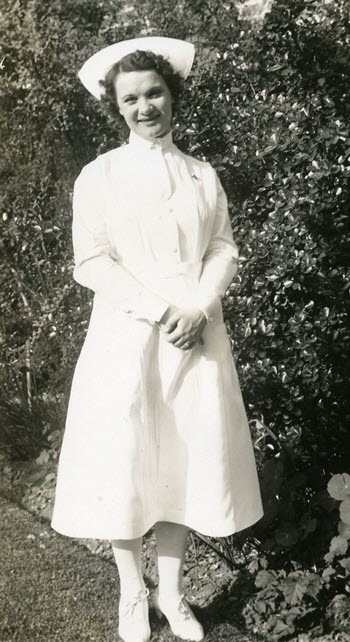
Grandma was proud to be a nurse and I’m proud to tell her story.
By the time I had pulled everything together from 1930 to 1933, I had more than enough for a nice size book: “A Nurse in Training.”
Tips to Create Family History Books
It’s really important to create your book with your “customer” in mind: your family member who will be reading the book. So here are my top tips for making your book fascinating to your reader:
#1. Convey an overall theme
Review all the available material that you have. That will give you a sense of what stories you can tell and, hopefully, a sense of your ancestors’ goals, experiences and emotions.
In the case of “A Nurse In Training,” I wanted to communicate my grandmother as a young woman, taking on a new adventure away from home. Both funny times and deeply challenging times formed the foundation of this warm, caring woman’s successful career. And she just happened to meet her husband at the same time!
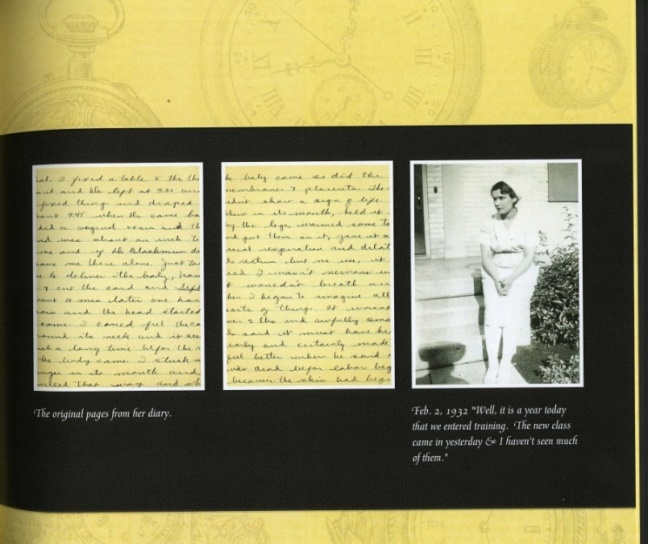
A page from “A Nurse in Training.”
You don’t need every scrap of research and every photo to get this theme across. It’s your job to be a sharp editor to pick out the critical pieces.
#2. Make it readable in one sitting.
Like it or not, if the book takes too long read, your relatives won’t. Strive to create a book that doesn’t look intimidating.
I create books that are 20 double-sided pages. People will be willing to pick up a thinner book off the coffee table. And if it’s well done, they’ll find that they’ve suddenly finished the entire book without once thinking of putting it down! Hopefully they’ll walk away with a real sense of having gotten to know that ancestor.
#3. Fill it with the best of what you have.
This goes back to conveying the theme and being a tough editor.
My grandma had many funny stories, but there just wasn’t room for all of them. I picked only the best of the best. Anyone who reads the book should hopefully come away with the fact that my grandma had a sense of humor and could laugh at herself.
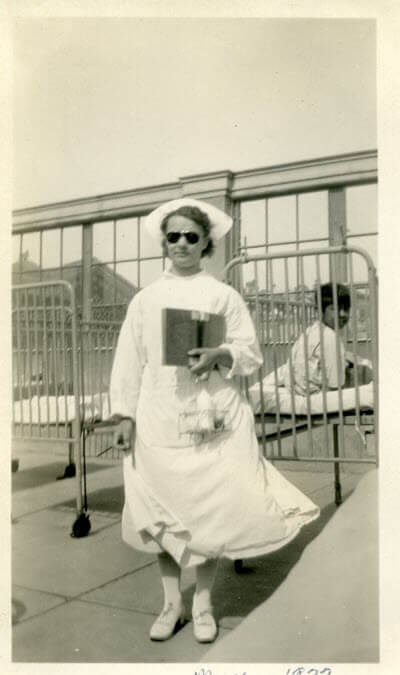
Grandma working the TB ward at San Francisco Hospital in 1933
I made sure some of the most compelling stories were at the beginning: if you can capture their interest in the first three pages, you’ll have them hooked for the entire book.
#4. Pack it with photos and graphics.
A picture is definitely worth a thousand words. And since words in a small book will be limited, photographs will be your best friend.
If you’re lacking in family photos, consult my Genealogy Gems Podcast episodes for countless ideas for finding appropriate images.
In A Nurse In Training, I included scanned images of skating rink tickets, programs and announcements from my grandma’s scrapbook and journal pages in my grandmother’s own hand. These types of items really add texture and interest to a book, and help the reader to see that you’ve really done your homework.
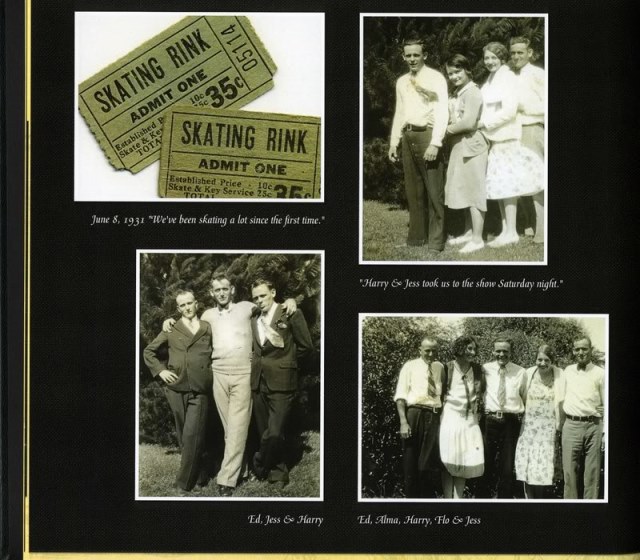
#5. Keep it in chronological order.
This seems obvious, but it’s easy to get side-tracked and start going back and forth in time. Believe me, for the reader’s sake, use dates and keep things in chronological order.
You as the researcher know this information backwards and forwards, but this is probably your reader’s first exposure to it. Be gentle with them and keep it straightforward and simple. Your reader will thank you.
#6. Choose quality!
High-quality glossy pages, good image quality and a hard cover binding all shout to the reader, “I’m worth your time! Read me!”
For example, I found a drawing of Dameron Hospital, which was part of my grandma’s story, but it was a low quality image and didn’t look good in the book. As much as I wanted to include it, I ended up leaving it out, and I’m glad I did. It wasn’t critical to my theme, and there were other ways to illustrate the hospital setting for the reader.
From Book to Movie: Create Your Own Family History Videos
My “Nurse in Training” book eventually became the basis for my very first family history videos. Watch them here–and see how I turned her own words into an illustrated narrative:
 Next Step: Turn Your Family History Book Into a Movie
Next Step: Turn Your Family History Book Into a Movie
I created these before do-it-yourself video services like Animoto made it so easy. (And I think that’s why I appreciate them so much!)
If you’d like to put an ancestor’s story into video format but you’re not sure how, try writing it up as a short book first. By the time you’re finished, you’ll have an excellent start on your “screenplay.” You’ll also have a great little book to send loved ones as a gift. (If you do eventually turn that story into a short video, they’ll love it even more, because they’ll already know the story that they will see come alive on the screen.)
Click here to learn step-by-step how to create your own family history video.

